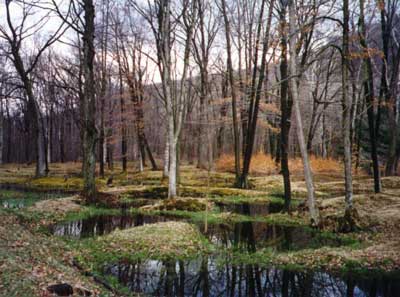 |
||||||
Pre-Columbian Mining
North America's early inhabitants, the Native Americans, had uses for crude oil to the degree that they conducted mining operations in the Oil Creek flats and elsewhere. The mines consisted of pits which were dug so close together that the septa between them were hardly more than narrow paths. The pits were about seven or eight feet long, four to eight feet wide and six to ten feet deep. Deeper and bigger pits have been reported, the longest being 35 feet. The shapes were square, circular or oblong.
 |
Special purpose sites in the Drake Well Memorial Park near Titusville, Pennsylvania. Vestiges of former Pre-Columbian oil pits are visible. Archaeologists have excavated some of them. Drake drilled his 1859 well nearby. Photo 1997 by S.T. Pees. |
The subject pits were dug in the valley alluvium and glacial outwash. They were shored in some instances by vertical timbers. Ladders have been found in some pits. They were made of pine trunks with the branches cut to leave lengthy stubs to serve as steps. The preparation of the timbers in the pits was done by stone axes as evidenced by the bite marks on the fashioned wood. Collection devices made of tree branches, twigs, leaves and clay were present in the bottom of some pits (Curtis, 1971). This was a subsurface mining enterprise and the pits have been referred to as special purpose sites.
The location of the pits is in the same seep area that later was to attract Edwin L. Drake who, after trying mining (he dug a shaft) to no avail, commenced a drilling operation which succeeded in 1859. Drake's well and the much earlier Native Americans' pits are on the east bank of Oil Creek less than a mile south of Titusville and actually fall in the northeast comer of Cherrytree Township in northern Venango County. The Drake Well Memorial Park and an adjacent portion of Oil Creek State Park (on the south) include the well site, a number of the pits, and the remains of other operations.
Documentary searches and archaeological work on these pit mines have been conducted several times by investigators. The most recent work was done by the Mercyhurst Archaeological Institute, Erie, Pa, in the period 1996 to 1998. A thorough documentary search was undertaken by these researchers, Then a hewn piece of wood (less than one foot long) earlier recovered from one of the pits by archaeologist Sue Ann Curtis, was sent to the University of California at Riverside where it was subjected to nine radiocarbon dating tests. These duplicate analyses gave a high confidence level. The dates calibrated to A.D, 1415-1440. Based on this strong evidence, the oil mining operation at this site was Pre-Columbian and thereby long antedated the first presence of Europeans in northwestern Pennsylvania.
It is interesting to note that the Pre-Columbian miners shored some of their pits with large timbers placed vertically around the earthen walls. These timbers probably prevented caving of the alluvium through which the miners had dug. In 1858 Drake had the same problem in a shaft which kept caving in. He abandoned it. When he began drilling in 1859 he found that the well's surface hole caved in too. This led to his important invention of the drive pipe which secured the borehole walls. It can be likened to the cribbing or shoring of the new Pre-Columbian pits which is believed to have served the same purpose.
The subsurface mechanism that supplied the seep and the near-surface oil would be either or both of the following:
1. Broaching of the shallow, stray sandstone reservoir by glacial scour thus allowing escape of oil (Dickey, 1941). This erosion was quickly followed by deposition of surficial material (outwash).
2. Natural fractures and joints in the stray sandstone reservoir and in overlying shales that provided conduits for escape of the formation fluids.
The top of bedrock in the Drake seep area is found at +/-32 feet depth as judged by the thickness of the unconsolidated section encountered in the Drake borehole. The stray oil-bearing sandstone was thought to be only 2 1/2 feet thick. The total depth of the hole was 69 1/2 feet with the basal 1/2 foot being a fracture or joint in the sandstone.
![]()
| © 2004, Samuel T. Pees all rights reserved |
|